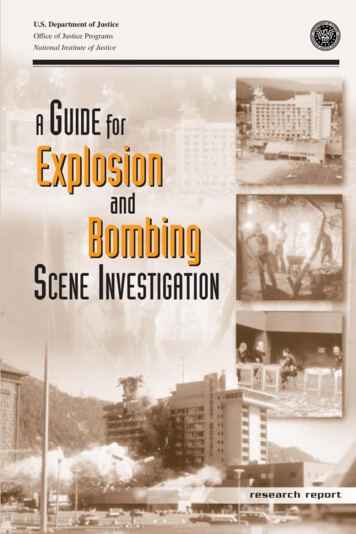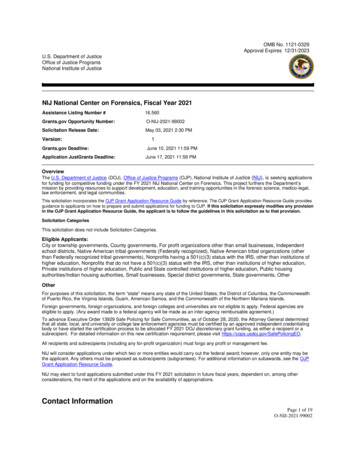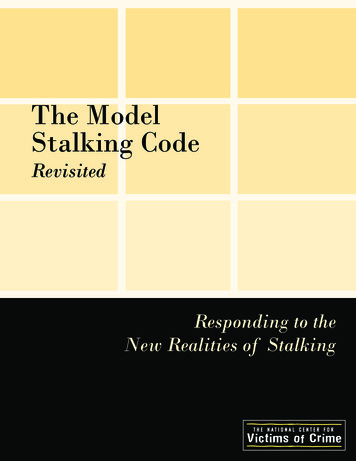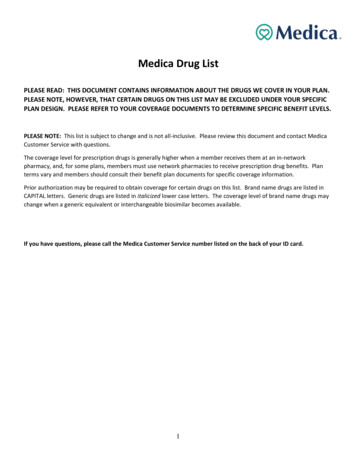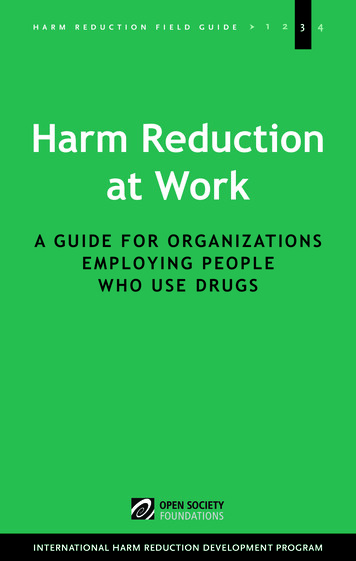
Transcription
Drug-Facilitated Rape:Looking forthe Missing PiecesPhoto source: PhotoDiscby Nora Fitzgerald and K. Jack Riley
about the authorsore than 430,000 sexualassaults occur annually inthe United States, according to victimization surveys.1 Manyof these assaults involve alcohol anddrugs,2 which are often used voluntarily by both victim and offender.3,4But in the mid- and late 1990’s,ethnographers and rape crisis centers began hearing reports of drugs,often referred to as “roofies” and“liquid ecstasy,” being administeredclandestinely to immobilize victims,impair their memory, and thus facilitate rape. Two drugs in particularwere mentioned in these reports:Rohypnol (the pharmaceutical tradename for flunitrazepam) and GHB(gamma-hydroxybutyrate).MThese drugs can produce loss ofconsciousness and the inabilityNora Fitzgerald is a Social Science Analyst at the National Institute of Justice.K. Jack Riley, Ph.D., is Director of the Criminal Justice Program at RAND. Fitzgeraldand Riley (who at the time was Director of NIJ’s Arrestee Drug Abuse Monitoring program)led the Department of Justice working group that conducted the research and wrotethe report upon which this article is based.to recall recent events. Victimsmay not be aware that they haveingested drugs or that they havebeen raped while under the influence of drugs.5 Reports of suchassaults and increases in the recreational consumption of the drugsused in these assaults have broughtdrug-facilitated rape into sharpfocus in recent years.This article summarizes findingsabout drug-facilitated rape learnedby researchers at the U.S. Depart-How This Article Came to BeIn December 1997, the U.S. AttorneyGeneral directed the Department ofJustice to assess the problems posedby drugs being used to facilitate rape.A working group chaired by NIJ DirectorJeremy Travis and representatives fromseveral other Justice Department agenciesbegan meeting regularly to structure theinquiry and review progress.The investigation then turned to a numberof other data sources representing different perspectives: ethnographers, the printmedia, Internet-based data, law enforcement, victim advocates, policymakers,and the pharmaceutical industry. Thesearch uncovered a considerable amountof conflicting information amid differingviewpoints.The group’s overarching objective was toassess the state of knowledge about drugfacilitated rape and report back to theAttorney General within several months.The working group learned a great dealfrom its investigation but could draw noconclusions beyond a clear recognitionthat the incidence of this offense is extraordinarily difficult to measure, that existing indicators are incapable of monitoringthe problem, and that the true magnitudeof the problem cannot be known with certainty from the scientific methods thathave been used to date.The group’s first step was to determinehow often drug-facilitated rape occurs.There are no national statistics for thisoffense (such as would be provided bythe Uniform Crime Reports, the NationalCriminal Victimization Survey, or theNational Judicial Reporting Program),so the group conducted a thorough reviewof other, nonnational-level research. Thissearch revealed that no empirical dataexist to answer the question.To learn how to obtain a copy of the fullreport, see “For More Information” onpage 15.ment of Justice in response to arequest from the Attorney Generalfor more information about thisnew phenomenon. (See “How ThisArticle Came to Be.”)What Are RapeFacilitating Drugs?Sexual assault victims who believedrugs were surreptitiously given tothem typically report rememberingsensations of drunkenness that donot correspond with the amountsof alcohol consumed, unexplainedgaps in memory, altered levels ofconsciousness, and unexplainablesigns of physical trauma. The mostcommonly implicated drugs areRohypnol and GHB.Rohypnol, or flunitrazepam,belongs to a class of drugs calledbenzodiazepines and is approvedfor use in 80 countries, but not inthe United States or Canada. It isavailable only in pill form, is tasteless, odorless, and colorless, and dissolves to some degree in liquid.Benzodiazepines are used primarilyto produce sedation, sleep, or muscle relaxation; to reduce seizures andanxiety; and to produce anterogradeamnesia, a desired effect for somesurgical procedures. Anterogradeamnesia is a condition in whichevents that occurred during the timethe drug was in effect are forgotten,in contrast to retrograde amnesia, inwhich events prior to the intervening agent are forgotten.Rohypnol mentally and physicallyincapacitates an individual, particularly when used in combinationNational Institute of Justice Journal April 20009
Description ofData SourcesMonitoring the Future (MTF): This ongoingsurvey of 8th, 10th, and 12th graders uses anational probability sample. Sponsored bythe National Institute on Drug Abuse. Visithttp://www.monitoringthefuture.org.Drug Abuse Warning Network (DAWN):DAWN records instances of emergencyroom visits and deaths related to particulardrugs. Sponsored by the SubstanceAbuse and Mental Health Services Administration. Visit http://www.samhsa.gov nity Epidemiology WorkingGroup (CEWG): This ethnographic reportingsystem, in place in 21 metropolitan areas,supplements findings from nationaldrug data systems. Sponsored by theNational Institute on Drug Abuse. Visithttp://www.nida.nih.gov.Pulse Check: This ethnographic reportingsystem covers 20 metropolitan areas.Sponsored by the White House’s Officeof National Drug Control Policy. Visithttp://www.whitehousedrugpolicy.gov.with alcohol, and is capable ofproducing anterograde amnesia.GHB, a drug first synthesized inthe 1920’s, occurs naturally in thehuman body in minute amounts. Itwas under development as an anesthetic agent in the late 1950’s andearly 1960’s, but no commercialproducts were developed fromthese efforts. Until the FDA bannedthe drug in 1990, it was availablethrough health food stores and marketed as both a sleep aid and as abody-building supplement. Severalvendors distributed products containing GHB under trade namessuch as “Gamma Hydrate” and“Somatomax PM.”GHB is marketed in some Europeancountries as an adjunct to anesthesiaDrug-Facilitated Rape: Looking for the Missing Pieces10and currently is being tested fortreatment of narcolepsy as well asalcohol addiction and withdrawal(with mixed results) in Europe andthe United States.6How Common IsDrug-FacilitatedRape?No one really knows how commondrug-facilitated rape is becausetoday’s research tools do not offera means of measuring the numberof incidents. However, recent findings from ethnographic researchand school-based surveys can provide insight into the voluntary useof these drugs.Flunitrazepam first appeared inearly warning ethonographic systems in December 1993, when itwas reported among Miami highschool students.By 1995, the Community Epidemiology Working Group (CEWG)found that use of Rohypnol wasspreading in Florida and Texas.Pulse Check reported Rohypnol usewas rising, particularly among youthand young adults. Ethnographers inFlorida and Texas reported thatlocal law enforcement agents wereseizing more Rohypnol tablets,often still in the manufacturer’spackaging.In 1996, Monitoring the Future(MTF) began tracking Rohypnol. In1999, MTF found that 0.5 percent of8th graders and 1.0 percent of 10thand 12th graders had reported usingRohypnol in 1998, a level slightlybelow those found a year earlier.7Such rates appear low in comparison to marijuana or amphetamineuse, but they are not trivial—10thand 12th graders report similarlevels of heroin use.8In 1997, Pulse Check noted thatalthough Rohypnol continued tobe available in Florida and Texas,distribution had slowed.In 1998, Texas’ statewide studentsurvey, which uses the same methodology and many of the sameitems as MTF, found that 1.3 to 2.1percent of Texas students in grades8 to 12 reported use of Rohypnolduring the school year.9 Later in1998, Pulse Check reported thatRohypnol was in use in Florida,Hawaii, Minnesota, and Texas.Mention of widespread recreationaluse of GHB only recently has beenreported by CEWG in December1997. In winter 1998, Pulse Checkreported use of GHB in many urbanareas.The Drug Abuse Warning Network(DAWN) also has captured information about GHB because of overdoses. The Drug EnforcementAdministration has documentedapproximately 650 overdoses and20 deaths related to GHB. MTFadded questions about GHB to itsyear 2000 survey.Available law enforcement statisticson seizures and trafficking (primarily from the Drug EnforcementAdministration) tend to corroboratethe ethnographic and survey data.Ethnographic measures may notrepresent the true scale of the drugs’use, however, and more rigorousscientific measures have not beenin place long enough to giveresearchers the ability to projectaccurate trends.Another factor complicating science’s ability to measure the incidence and prevalence of these drugsis the lack of law enforcement evidence. Investigations of suspecteddrug-facilitated assaults often turnout to be inconclusive because manyvictims do not seek assistance untilhours or days later, in part becausethe drugs have impaired recall andin part because victims may not recognize the signs of sexual assault. Bythe time they do report a suspectedassault, conclusive forensic evidencemay have been lost. Even when
victims do suspect a drug-facilitatedrape and seek help immediately, lawenforcement agencies may not knowhow to collect evidence appropriately or how to test urine using thesensitive method required. (Seefurther discussion of investigationpolicies below and in the sidebar“Learning From Victims.”)To add more complexity to the puzzle, school-based surveys seem tosuggest that Rohypnol and GHBare consumed voluntarily, perhapsincreasingly so, because these drugsare cheap, easy to share, and easy tohide. Use appears to be concentratedamong populations that also are atthe highest risk of sexual assault,including middle school, highschool, and college-age students.Learning From Victimsby Gail Abarbanel, LCSWGail Abarbanel is the director of theRape Treatment Center (RTC) atSanta Monica–UCLA Medical Center.Established in 1974, the RTC hastreated more than 20,000 sexualassault victims. The RTC’s informational materials on drug-facilitatedrape are distributed throughout theUnited States.In late 1995, the Rape TreatmentCenter at Santa Monica–UCLAMedical Center began to see anew pattern in sexual assault cases.Victims were coming in who believedthey had been drugged surreptitiouslyto incapacitate them for the purposeof sexually assaulting them. Many ofthese cases followed a similar pattern. Victims were in what seemedlike a comfortable social environment, such as a restaurant, party, orclub. Unbeknownst to them, someoneslipped a drug into their drink. Asthey consumed the drink, they beganto feel disoriented or sick. The nextthing they remembered was wakingup hours later, sometimes in adifferent location.When they regained consciousness,some victims were unsure if they hadbeen sexually assaulted. Others foundsigns that they had been: They wereundressed; they had semen stains ontheir bodies and/or clothing; they hadvaginal or anal trauma, such as soreness and/or lacerations. All of thesevictims reported significant memoryimpairment. Most could not recallwhat was done to them, who participated, or how many people werepresent while they were unconscious.Some could remember brief, intermittent periods of awakening, duringwhich they were aware of their surroundings but were unable to moveor speak. They felt “paralyzed.” Onevictim said, “I came to and saw thisguy on top of me about to rape me,but I couldn’t move my arms or legs.Then I passed out again.”It was apparent to the staff at theRape Treatment Center that somerapists were using a powerful newweapon to overpower, disable, andcontrol their victims.When victims began to report thesecrimes to the authorities, their casesoften were dismissed. One victim wastold, “He has his memory, you don’thave yours. There’s no evidence.The case is closed.”In many instances, crucial physicalevidence was never gathered fromvictims or crime scenes. For example, even when sexual assaultevidentiary examinations wereconducted, urine specimens neededto detect traces of the drugs wereomitted because, in most jurisdictions, urine samples were notroutinely included in standardizedrape kits. As a result of thesedeficiencies, many victims feltrevictimized by the agencies thatwere supposed to help them.When these cases initially appeared,there was little information in theprofessional literature or in newscoverage about rape drugs or drugfacilitated sexual assaults. Victimswere a crucial source of information.Their reports helped define thisemerging crime pattern by identifyingthe characteristics of these crimesthat distinguished them from othersexual assaults.In addition, the problems victimsencountered suggested an urgentneed for a comprehensive, broadbased community response, including new protocols for hospitals,police departments, and crime labs;updated rape evidence kits; trainingfor police officers, prosecutors,rape crisis centers, and other victimservice providers; public policy andlegislative reforms; research; andpublic education and preventionprograms.What Victims HaveTaught UsHow Rape Drugs Facilitate SexualAssaults. Rape drugs make itrelatively easy for rapists to gaincontrol of their victims. Perpetratorsdo not have to overcome any form ofresistance. They do not have to usephysical force. They do not have tothreaten to harm the victim to getcompliance. Nor do they have to beconcerned about a victim’s screamsattracting attention. The drugs theyadminister immobilize and silencethe victim.(continued on page 12)National Institute of Justice Journal April 200011
Learning From Victims (continued from page 11)How Victims are Prevented FromDetecting Threats to Their Safety.Victims of these crimes do not senseany threat to their safety when theassailant is incapacitating them.The “weapon” used to overpowerand disable them is invisible. It ishidden in a drink.How Victims are Inhibited FromExercising Self-Defense. The abilityto sense danger is critical to a person’s ability to implement self-defensestrategies. When faced with the threatof being raped, most people employone or more protective measures,such as verbally negotiating with theassailant, cognitively assessing theiroptions, screaming, stalling, attempting to escape, and/or physically resisting. If these efforts fail to prevent therape, victims may “fight back” in otherways. They may use their sensory andcognitive abilities to memorize detailsabout the assailant’s physical characteristics, the location of the crime, andother factors that can later be used toaid authorities in apprehending andprosecuting the offender.The incapacitating effects of rapedrugs rob victims of their ability touse these coping strategies. Onevictim said, “Rape is never a fairfight, but I didn’t even have achance to defend myself.”How Rapists Can Appear to BeRescuers. When victims are druggedin places where other people are present, such as restaurants, clubs, bars,and parties, the rapist may appear tobystanders and witnesses to be a rescuer. The behavioral effects of rapedrugs look very much like the effectsof voluntary alcohol consumption. Toonlookers, the victim may seem drunk.When the rapist carries or leads thevictim to another location where thesexual assault will be committed,he may be viewed as “helping” ortransporting a vulnerable person to asafe place.How Rape Drugs Affect ReportingPatterns. Victimization surveysconsistently indicate very low reporting rates among rape victims. Delayedreports also are common, particularlyin acquaintance rapes. The reasonsare well documented in the literature.In drug-facilitated rapes, additionalfactors may account for low anddelayed reporting, including theimmediate and residual effects of thedrugs (the victim may be unconsciousfor several hours after the assault andmay have hangover effects afterregaining consciousness); feelingsof guilt or self-blame because of priorvoluntary ingestion of alcohol and/ordrugs; confusion and uncertainty aboutwhat happened; and reluctance tomake an accusation without personalknowledge or memory of the assaultcircumstances.How Victims’ Inability to RecallWhat Happened Affects theSystem’s Response. Many aspectsof a rape investigation are facilitatedby a victim’s ability to describe whathappened. The victim’s narrative helpsguide the medical/evidentiary examination and the police investigation.In addition, it may be an importantconsideration in prosecutor filing decisions and judgments about credibility.When victims of drug-facilitated rapescannot give a complete narrative, theyoften encounter suspicion, disbelief,and/or frustration. Their inability tosupply information that could assistthe investigation and/or prosecutioncompounds their sense of helplessness.How People Misjudge and MinimizeVictims’ Trauma. Because most victims of drug-facilitated rapes have nomemory of the sexual assault, peoplemay mistakenly minimize the traumaDrug-Facilitated Rape: Looking for the Missing Pieces12they suffered. One victim was told,“You’re lucky you can’t remember,you won’t suffer as much as othervictims.” For all rape victims, theloss of control experienced duringan assault is profoundly traumatic. Indrug-facilitated rapes, the additionaldeprivation of cognition during theassault, combined with anterogradeamnesia afterwards, subjects thevictim to an extreme form of powerlessness.How Drugging Is a Unique Formof Trauma. Many of the difficultiesvictims face in the aftermath of theseassaults are due to the effects of thedrugs given by offenders. The surreptitious drugging of a victim is, in and ofitself, a cruel and criminal violation ofthe person. Some victims describethis aspect of the trauma as “mindrape.” The drugging should be recognized as a separate and distinct act ofvictimization in addition to any otheracts of abuse and degradation towhich the victim was subjected.How Being Unable to ForgetCompares With Being Unable toRemember. In the aftermath of rape,most victims suffer acute stress disorder and post-traumatic stress disordersymptoms. One of the most disturbingsymptoms is their inability to forgetwhat happened. The trauma is reexperienced repeatedly. Victims commonlyhave recurrent, intrusive recollectionsof the rape, including thoughts, flashbacks, and nightmares. For victims ofdrug-facilitated rapes, this aspect ofthe aftermath may be experienceddifferently. Because they cannot recallwhat happened during a significanttime period, they have to cope with agap in their memory. They experiencethe horror, powerlessness, and humiliation of not knowing what was done tothem. They can only imagine whathappened. One victim said, “I wouldrather have the nightmare.”
Drug-facilitated rape may be initiatedin social settings, like parties and clubs,not traditionally considered high-riskenvironments. Prevention strategies mustconsider reaching new audiences, such asbartenders, party hosts, cab drivers, andothers who might frequent places wheredrug-facilitated rapes are initiated orwho might see the victim immediatelyprior to the assault.The good news is that public awareness about the drugs and theireffects appears to be increasing.What Is Being Doneto Reduce DrugFacilitated Rape?Although current measuringmethods do not reveal exactly howwidespread drug-facilitated rape is,research does make it clear that therisk is real.Since reports of drug-facilitatedrape first started appearing, policymakers at the Federal level havemoved to address the situation. Onestep was to improve enforcement atthe U.S.-Mexican border of the banon importation of flunitrazepam.Then in October 1996, PresidentClinton signed the Drug-InducedRape Prevention and PunishmentAct, which provides harsh penaltiesfor distribution or possession of flunitrazepam. In February 2000, thePresident signed similar legislationrelated to GHB.The Office for Victims of Crime(OVC) within the Department ofJustice currently is providing training and technical assistance for amodel program designed to promote promising practices in sexualassault medical evidentiary exams.The program, which promotesthe use of specially trained sexualassault nurse examiners, hasdeveloped a guide that addressesthe issues of drug-facilitated rape,with specific information andguidance regarding comprehensivedrug testing and an exam protocol.National and local victim serviceorganizations have responded to thesituation by developing campaignsto raise awareness. A Los AngelesCounty task force developed a rapekit and procedures designed toimprove the way evidence is gathered in suspected cases of drugfacilitated rape. The task forcemembers included the Rape Treatment Center at Santa Monica–UCLA Medical Center, the LosAngeles County District Attorney’sOffice, the Los Angeles PoliceDepartment, and the County ofLos Angeles Sheriff ’s Departmentcrime labs.What Are theImplications forDecisionmakers?Practices and strategies to reducesexual assault may help reducedrug-facilitated sexual assault, butthere are unique aspects to drugfacilitated rape that demand tailoredstrategies.Environment Within Which theCrime Occurs. Drug-facilitatedrape may be initiated in social settings, like parties and clubs, nottraditionally considered high-riskenvironments. Prevention strategiesmust consider reaching new audiences, such as bartenders, partyhosts, cab drivers, and others whomight frequent places where drugfacilitated rapes are initiated or whomight see the victim immediatelyprior to the assault.Education of TargetedAudiences. Educational programsneed to be targeted to high-riskpopulations—high school andcollege-age people and people whofrequent nightclubs and resorts—rather than to more generalaudiences.Investigation Policies. The mostnumerous implications relate toforensic and investigation practices. Interviewing Techniques.Drug-facilitated rape casesrequire interview techniquesthat can help identify a sexualassault case when the victimhas memory gaps around theincident or isn’t aware of beingraped. When an interviewer suspects the victim has ingested aNational Institute of Justice Journal April 200013
rape drug, the victim should beasked to provide both urine andblood samples using establishedtimeframes and guidelines forcollection and preservation offorensic evidence.substances were produced orstored, and any vehicle used totransport the victim.Investigators should be trainedto look for specific types ofevidence that have been presentin other cases. Drug-relatedevidence may be found in theglasses from which the victimdrank, containers used to mixdrinks, and trash cans wherethese items were discarded. Inone case, traces of GHB werefound in the box of salt that wasused to make margaritas. GHBis often carried in small bottles,such as eye drop bottles. It isoften administered in sweetdrinks, such as fruit nectars andliqueurs, to mask its salty taste.In addition, even though thevictim’s memory of the assaultmay be extremely limited, consent should be obtained to conduct a thorough and completemedical/evidentiary examination. Oral, anal, and vaginalsamples should be taken evenwhen there is no visible trauma. Importance of a Urine Specimen. Rape drugs are more likelyto be detected in urine than inblood, and the urine specimenshould be collected as soon aspossible. This can be done priorto commencement of the lawenforcement interview and theforensic medical examination.Appropriate measures shouldbe implemented to ensure thatother potential evidence, suchas sperm or semen, is protectedwhen urine specimens arecollected.Law enforcement personnel,who are often the “first responders,” should be aware of theimportance of urine specimensin these cases. Victims should betransported immediately formedical care. If the victim musturinate before arriving at a medical care facility, the urine specimen should be saved in a cleancontainer and brought to themedical facility. The chain ofcustody should be documented. Crime Scene Evidence. Thecrime scene also should besecured and examined immediately or critical evidence maybe irretrievably lost. Drugfacilitated rape cases may involvemultiple crime scenes, for example, the location of the drugging,the location of the sexualassault, locations where illegalDrug-Facilitated Rape: Looking for the Missing Pieces14Recipes for making GHB may befound on an offender’s computer. In several cases, rapists whoused drugs to incapacitate theirvictims also photographed orvideotaped them. These picturesled to the identification of additional victims of the sameoffenders. Rape Evidence Kits. Standardized rape kits should be updatedto include instructions andcontainers for the collectionof urine specimens as well asblood in all cases in which drugfacilitated rape is suspected. Injurisdictions that do not have astandardized rape kit, a multiagency task force composed ofpolice officers, prosecutors, hospital personnel, crime lab technicians, and rape crisis counselors should develop one andmonitor compliance. A forensiclaboratory with the capabilityof conducting toxicology testsshould be identified because notall crime labs have the specialized equipment needed to testfor rape drugs. Proceduresshould be implemented topreserve the chain of custodyof the evidence.Where Do We GoFrom Here?Only four substantial studies of theprevalence and incidence of drugfacilitated rape were under way inlate 1999 when this article was prepared, but none will provide anaccurate measure of the situation.Three do not interview victimsand therefore cannot factor inrecreational use of Rohypnol orGHB. The fourth, a study by theUniversity of Cincinnati and fundedby NIJ, asks victims specifically ifsomeone has ever placed Rohypnolin a beverage but does not link theresponses to sexual assault victimizations or recreational use.To understand more about drugfacilitated rape, a research agendashould include the following: Expansion of existing Federaldata systems to provide information on drug-facilitated rape.The National Crime Victimization Survey may be an appropriate means for collectingpopulation-based informationon the incidence of this offense. Collection of new data in thefields of pharmacology andoffender profiling. Ethnographic studies to developa better understanding of thenature of this offense, includingthe most likely victims and therisk factors for victimization. A major multiyear, multimethodresearch initiative structured asfour separate studies designed tomeasure the incidence of drugfacilitated rape among suspectedcases, within the general population, among high-risk populations, and in the context ofacquaintance rape. Funding for development ofnew drug detection technologies, such as hair analysismethods.
Some of the ethnographic andnewspaper reporting on Rohypnoland GHB, which the Department ofJustice working group tracked, hasbeen driven in part by sporadicsigns of increased recreational useand overdoses. But the more important impetus for further studyappears to be reports from peoplewho turn to rape counseling centersand clinics with complaints andsuspicions that they have beenvictimized.For More Information Fitzgerald, N., K.J. Riley, T. Alston, C. Mamalian, M. Mendez, A. Resnick, B. Taylor, andJ. Wiseman, Report to the Attorney General From the Drug-Facilitated Rape WorkingGroup, Washington, D.C.: U.S. Department of Justice, National Institute of Justice, 1998(NCJ 181396). To obtain a copy, contact the National Criminal Justice Reference Serviceat P.O. Box 6000, Rockville, MD 20849–6000, 1–800–851–3420. Nora Fitzgerald, Social Science Analyst, National Institute of Justice, 810 Seventh StreetNW., Washington, D.C. 20531, 202–305–1547, fitzgera@ojp.usdoj.gov. The National Institute on Drug Abuse’s party drugs Web site: http://www.clubdrugs.org. Anglin, D., K.L. Spears, and H. Range Hutson, “Flunitrazepam and Its Involvement inDate or Acquaintance Rape,” Journal of Academic Emergency Medicine 4(4) (1997). Calhoun, S.R., D.R. Wesson, G.P. Galloway, and D.E. Smith, “Abuse of Flunitrazepam(Rohypnol) and Other Benzodiazepines in Austin and South Texas,” Journal ofPsychoactive Drugs 28(2) (April–June 1996). Inciardi, J.A., and C.A. Saum, “Rohypnol Misuse in the United States,” Journal ofSubstance Use and Misuse 32(6):723 (1997). Woods, J.H., and Gail Winger, “Abuse Liability of Flunitrazepam,” Journal of ClinicalPsychopharmacology 17,(3) (June 1997), Supp. 2.NCJ 181731Notes1. Perkins, Craig, and Patsy Klaus,Criminal Victimization 1994,National Crime VictimizationSurvey Report, Washington,D.C.: U.S. Department ofJustice, Bureau of JusticeStatistics, April 1996 (NCJ158022). The number of rapesreported on victimization surveys, however, differs widelyfrom the number reported tothe police. In 1996, 95,770forcible rapes were reported tothe police, representing approximately 28 percent of the numberof rape victims reported in theNational Crime VictimizationSurvey.2. Levine, E.M., and E.J. Kanin,“Sexual Violence Among Datesand Acquaintances: Trends andTheir Implications for Marriageand Family,” Journal of FamilyViolence 2(1):55–65 (1987).3. Richardson, D.R., and G.S.Hammock, “Alcohol andAcquaintance Rape,” inA. Parrot and L. Bechhofer(eds.), Acquaintance Rape: TheHidden Crime, New York: JohnWiley and Sons, 1991, 83–95.4. A national survey based on asample of students in highereducation showed that 55 percent of female student victimsof acquaintance rape and74 percent of male studentperpetrators self-reported usingalcohol immediately before theassault. See Koss, Mary, “HiddenRape: Sexual Aggression andVictimization in a NationalSample of Students in HigherEducation,” in Ann W. Burgess(ed.) Rape and Sexual Assault,vol. II, NY: Garland Publishing,1988.5. Calhoun, S.R., D.R. Wesson,G.P.
tems in December 1993,when it was reported among Miami high school students. By 1995,the Community Epidem-iology Working Group (CEWG) found that use of Rohypnol was spreading in Florida and Texas. Pulse Check reported Rohypnol use was rising, particularly among youth and young adults.Ethnographers in Florida and Texas reported that
